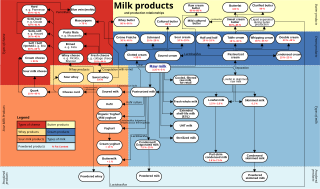
Dairy products or milk products, also known as lacticinia, are food products made from milk. The most common dairy animals are cow, water buffalo, nanny goat, and ewe. Dairy products include common grocery store food around the world such as yogurt, cheese, milk and butter. A facility that produces dairy products is a dairy. Dairy products are consumed worldwide to varying degrees. Some people avoid some or all dairy products because of lactose intolerance, veganism, or other health reasons or beliefs.
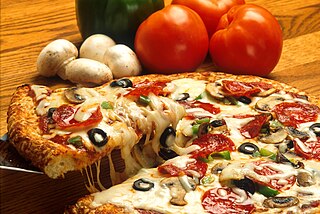
Pizza cheese encompasses several varieties and types of cheeses and dairy products that are designed and manufactured for use specifically on pizza. These include processed and modified cheese, such as mozzarella-like processed cheeses and mozzarella variants. The term can also refer to any type of cheese suitable for use on pizza. The most popular cheeses used in the preparation of pizza are mozzarella, provolone, cheddar and Parmesan. Emmental, pecorino romano and ricotta are often used as toppings, and processed pizza cheeses manufactured specifically for pizza are mass-produced. Some mass-produced pizza cheeses are frozen after manufacturing and shipped frozen.

Rennet is a complex set of enzymes produced in the stomachs of ruminant mammals. Chymosin, its key component, is a protease enzyme that curdles the casein in milk. In addition to chymosin, rennet contains other enzymes, such as pepsin and a lipase.
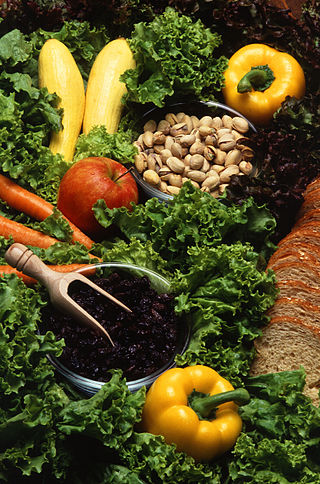
Vegetarian cuisine is based on food that meets vegetarian standards by not including meat and animal tissue products.

Textured or texturized vegetable protein (TVP), also known as textured soy protein (TSP), soy meat, or soya chunks is a defatted soy flour product, a by-product of extracting soybean oil. It is often used as a meat analogue or meat extender. It is quick to cook, with a protein content comparable to some meats.

Ice milk, or iced milk, is a frozen dessert made with frozen dairy milk, but with less milk fat than regular ice cream. Ice milk is sometimes priced lower than ice cream.

Processed cheese is a product made from cheese mixed with an emulsifying agent. Additional ingredients, such as vegetable oils, unfermented dairy ingredients, salt, food coloring, or sugar may be included. As a result, many flavors, colors, and textures of processed cheese exist. Processed cheese typically contains around 50 to 60% cheese and 40 to 50% other ingredients.

Cheesemaking is the craft of making cheese. The production of cheese, like many other food preservation processes, allows the nutritional and economic value of a food material, in this case milk, to be preserved in concentrated form. Cheesemaking allows the production of the cheese with diverse flavors and consistencies.
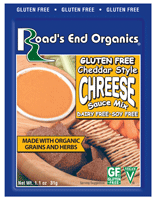
Chreese is a vegan cheese substitute made with nutritional yeast. The product is manufactured by Road's End Organics, a U.S. company that specializes in food for people with special dietary needs. Chreese is organic, lactose-free, cholesterol and saturated fat-free. It comes in a number of varieties, including a powder mix, a queso dip alternative, and as part of a "Mac & Chreese" line of pasta products.
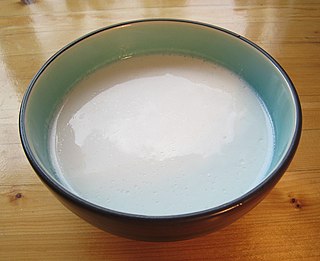
Plant milk is a plant beverage with a color resembling that of milk. Plant milks are non-dairy beverages made from a water-based plant extract for flavoring and aroma. Plant milks are consumed as alternatives to dairy milk, and may provide a creamy mouthfeel.

A milk substitute is any substance that resembles milk and can be used in the same ways as milk. Such substances may be variously known as non-dairy beverage, nut milk, grain milk, legume milk, mock milk and alternative milk.

Tofurky is the brand name of an American vegan turkey replacement made from a blend of wheat protein and organic tofu. Tofurky brand was officially introduced in 1995.

Cheese is a dairy product produced in a range of flavors, textures, and forms by coagulation of the milk protein casein. It comprises proteins and fat from milk. During production, milk is usually acidified and either the enzymes of rennet or bacterial enzymes with similar activity are added to cause the casein to coagulate. The solid curds are then separated from the liquid whey and pressed into finished cheese. Some cheeses have aromatic molds on the rind, the outer layer, or throughout.

Soy yogurt, also referred to as soya yogurt, soygurt or yofu, is a yogurt-like product made with soy milk.

There are many different types of cheese. Cheeses can be grouped or classified according to criteria such as length of fermentation, texture, methods of production, fat content, animal milk, and country or region of origin. The method most commonly and traditionally used is based on moisture content, which is then further narrowed down by fat content and curing or ripening methods. The criteria may either be used singly or in combination, with no single method being universally used.

Cheeses in Mexico have a history that begins with the Spanish conquest, as dairy products were unknown in pre-Columbian Mesoamerica. The Spanish brought dairy animals, such as cattle, sheep, and goats, as well as cheesemaking techniques. Over the colonial period, cheesemaking was modified to suit the mixed European and indigenous tastes of the inhabitants of New Spain, varying by region. This blending and variations have given rise to a number of varieties of Mexican cheeses. These are most popular in the country, although European cheeses are made, as well. Almost all cheese in Mexico is made with cows’ milk, with some made from goats’ milk. More recently, efforts have been made to promote sheep's milk cheeses. Most cheeses are made with raw (unpasteurized) milk. Cheeses are made in the home, on small farms or ranches, and by major dairy product firms. Between 20 and 40 different varieties of cheese are made in Mexico, depending on how one classifies them. Some, such as Oaxaca and panela, are made all over Mexico, but many are regional cheeses known only in certain sections on the country. Some of the least common are in danger of extinction.

Rumi cheese is one of the main types of cheese in Egypt. Despite its name, the cheese is Egyptian. Traces of it go back to the ancient Egyptians. It has a pungent smell, and different degrees of saltiness depending on the age.

Vegan cheese is a category of non-dairy, plant-based cheese analogues. Vegan cheeses range from soft fresh cheeses to aged and cultured hard grateable cheeses like plant-based Parmesan. The defining characteristic of vegan cheese is the exclusion of all animal products.

Cheese sauce is a sauce made with cheese or processed cheese as a primary ingredient. Sometimes dried cheese or cheese powder is used. Several varieties exist and it has many various culinary uses. Mass-produced commercial cheese sauces are also made by various companies, in both liquid and dry forms. These prepared sauces are used by consumers and restaurants, and commercial formulations are used in the production of various prepared foods, such as macaroni and cheese mixes and frozen meals.




















